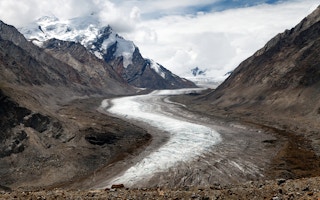A new study examining river basins in the Asia region suggests that amounts of water supplied to the area by glaciers and rainfall in the Himalayas will increase in the coming decades.
At first reading, that looks like good news, as an estimated 1.3 billion people in Pakistan, India, Bangladesh, Nepal, China and elsewhere are dependent for their water supplies on rivers fed by glaciers and snowmelt.
But the less welcome news is that scientists are unsure what will happen after 2050 if the rate at which glaciers melt continues to increase as a result of climate change.
Scientists say rising temperatures and more intense rainfall patterns in the higher Himalayas are causing the retreat of the majority of glaciers in the region.
Heat build-up
They say glacier melt is also being caused by black carbon – particulate matter that, in South Asia, comes mainly from cooking fires, the burning of waste, plus coal burning and diesel exhausts. The black carbon, or soot, falls on the glaciers, reducing reflectivity and increasing heat build-up.
This latest study of glacier melt and water flows, appearing in the journal Nature Climate Change, was carried out by scientists at Future Water, a Netherlands-based research group, Utrecht University, and the Nepal-based International Centre for Integrated Mountain Development.
“
Long-term outlook is particularly uncertain for the upper Indus basin. While glacier melt contributes only 11.5 per cent of the total runoff in the upper basin of the Ganges river, it contributes more than 40 per cent of total water runoff in the upper Indus basin
It assesses the contribution of glacier and snowmelt to the region’s river basins, incorporating some of the world’s mightiest rivers – the Indus, the Ganges, the Brahmaputra, the Mekong and the Salween.
The scientists say that highly-sophisticated modelling techniques were used to study the river basins in unprecedented detail.
They report: “Despite large differences in runoff composition and regimes between basins and between tributaries within basins, we project an increase in runoff at least until 2050, caused primarily by an increase in precipitation in the upper Ganges, Brahmaputra, Salween and Mekong basins and from accelerated melt in the upper Indus Basin.
“These findings have immediate consequences for climate change policies where a transition towards coping with intra-annual shifts in water availability is desirable.”
Uncertain supplies
But while the study says that, up to mid-century, little change is likely in the amount of glacier melt water flowing into river basins, it is unclear what will happen thereafter to the water supplies for what is a significant portion of the world’s population.
“Our study does not include projections after 2050,” Arthur Lutz, lead author of the study, told Climate News Network. “However, at some point in time, the contribution of glacier melt to the total flow will decrease, because of the decreasing glacier extent. When this happens, it will differ for different river basins and sub-basins.”
The study says the long-term outlook is particularly uncertain for the upper Indus basin. While glacier melt contributes only 11.5 per cent of the total runoff in the upper basin of the Ganges river, it contributes more than 40 per cent of total water runoff in the upper Indus basin.
The Indus river, which flows for nearly 2,000 miles from high up in the Hindu Kush-Karakoram Himalaya mountain range down to the Arabian Sea, is vital to life in Pakistan, providing water for 90 per cent of the country’s agricultural crops. Hydro plants along the Indus also supply about half the country’s electricity.










